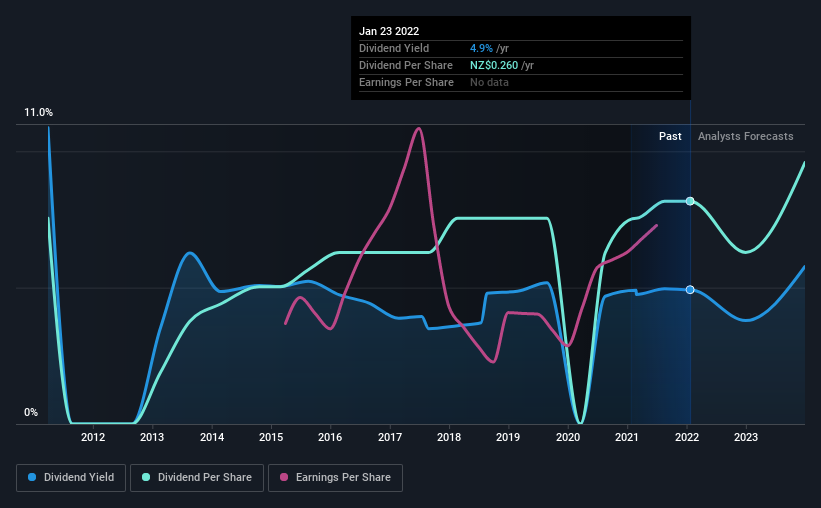Seeka Limited (NZSE:SEK) Looks Interesting, And It's About To Pay A Dividend
It looks like Seeka Limited (NZSE:SEK) is about to go ex-dividend in the next three days. The ex-dividend date occurs one day before the record date which is the day on which shareholders need to be on the company's books in order to receive a dividend. The ex-dividend date is of consequence because whenever a stock is bought or sold, the trade takes at least two business day to settle. Therefore, if you purchase Seeka's shares on or after the 27th of January, you won't be eligible to receive the dividend, when it is paid on the 23rd of February.
The company's next dividend payment will be NZ$0.15 per share, and in the last 12 months, the company paid a total of NZ$0.26 per share. Based on the last year's worth of payments, Seeka stock has a trailing yield of around 4.9% on the current share price of NZ$5.28. We love seeing companies pay a dividend, but it's also important to be sure that laying the golden eggs isn't going to kill our golden goose! We need to see whether the dividend is covered by earnings and if it's growing.
See our latest analysis for Seeka
Dividends are typically paid out of company income, so if a company pays out more than it earned, its dividend is usually at a higher risk of being cut. Seeka paid out a comfortable 42% of its profit last year. A useful secondary check can be to evaluate whether Seeka generated enough free cash flow to afford its dividend. Thankfully its dividend payments took up just 46% of the free cash flow it generated, which is a comfortable payout ratio.
It's positive to see that Seeka's dividend is covered by both profits and cash flow, since this is generally a sign that the dividend is sustainable, and a lower payout ratio usually suggests a greater margin of safety before the dividend gets cut.
Click here to see how much of its profit Seeka paid out over the last 12 months.
Have Earnings And Dividends Been Growing?
Businesses with strong growth prospects usually make the best dividend payers, because it's easier to grow dividends when earnings per share are improving. If earnings decline and the company is forced to cut its dividend, investors could watch the value of their investment go up in smoke. Fortunately for readers, Seeka's earnings per share have been growing at 10% a year for the past five years. Earnings per share have been growing rapidly and the company is retaining a majority of its earnings within the business. This will make it easier to fund future growth efforts and we think this is an attractive combination - plus the dividend can always be increased later.
Another key way to measure a company's dividend prospects is by measuring its historical rate of dividend growth. Seeka has delivered an average of 0.8% per year annual increase in its dividend, based on the past 10 years of dividend payments. Earnings per share have been growing much quicker than dividends, potentially because Seeka is keeping back more of its profits to grow the business.
Final Takeaway
From a dividend perspective, should investors buy or avoid Seeka? It's great that Seeka is growing earnings per share while simultaneously paying out a low percentage of both its earnings and cash flow. It's disappointing to see the dividend has been cut at least once in the past, but as things stand now, the low payout ratio suggests a conservative approach to dividends, which we like. It's a promising combination that should mark this company worthy of closer attention.
While it's tempting to invest in Seeka for the dividends alone, you should always be mindful of the risks involved. In terms of investment risks, we've identified 4 warning signs with Seeka and understanding them should be part of your investment process.
If you're in the market for dividend stocks, we recommend checking our list of top dividend stocks with a greater than 2% yield and an upcoming dividend.
Have feedback on this article? Concerned about the content? Get in touch with us directly. Alternatively, email editorial-team (at) simplywallst.com.
This article by Simply Wall St is general in nature. We provide commentary based on historical data and analyst forecasts only using an unbiased methodology and our articles are not intended to be financial advice. It does not constitute a recommendation to buy or sell any stock, and does not take account of your objectives, or your financial situation. We aim to bring you long-term focused analysis driven by fundamental data. Note that our analysis may not factor in the latest price-sensitive company announcements or qualitative material. Simply Wall St has no position in any stocks mentioned.

 Yahoo Finance
Yahoo Finance 
